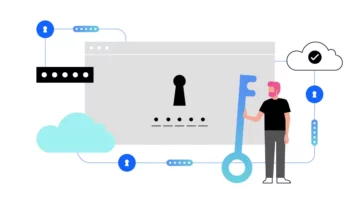<!—->
<!– –>

The latest findings of the IBM X-Force® Threat Intelligence Index report highlight a shift in the tactics of attackers. Rather than using traditional hacking methods, there has been a significant 71% surge in attacks where criminals are exploiting valid credentials to infiltrate systems. Info stealers have seen a staggering 266% increase in their utilization, emphasizing their role in acquiring these credentials. Their objective is straightforward: exploit the path of least resistance, often through unsuspecting employees, to obtain valid credentials.
Organizations have spent millions developing and implementing cutting-edge technologies to bolster their defenses against such threats, and many already have security awareness campaigns, so why are we failing to stop these attacks?
Challenges of traditional security awareness programs
Most security awareness programs today provide employees with information they need about handling data, GDPR rules and common threats, such as phishing.
However, there is one major weakness with this approach: the programs don’t consider human behavior. They typically follow a one-size-fits-all approach, with employees completing annual generic computer-based training with some slick animation and a short quiz.
While this provides necessary information, the rushed nature of the training and lack of personal relevance often results in employees forgetting the information within just 4-6 months. This can be explained by Daniel Kahneman’s theory on human cognition. According to the theory, every individual has a fast, automatic, and intuitive thought process, called System 1. People also have a slow, deliberate and analytical thought process, called System 2.
Traditional security awareness programs primarily target System 2, as the information needs to be rationally processed. However, without sufficient motivation, repetition and personal significance, the information usually goes in one ear and out the other.
It is crucial to understand employees’ behaviors
Nearly 95% of human thinking and decision making is controlled by System 1, which is our habitual way of thinking. Humans are faced with thousands of tasks and stimuli per day, and a lot of our processing is done automatically and unconsciously through biases and heuristics. The average employee works on autopilot, and to ensure that cybersecurity issues and risks are ingrained in their day-to-day decisions, we need to design and build programs that truly understand their intuitive way of working.
To understand human behavior and how to change it, there are a few factors we must assess and measure, supported by the COM-B Behavior Change Wheel.
- First, we need to know employees’ capabilities. This refers to their knowledge and skills to engage in safe online practices, such as creating strong passwords and recognizing phishing attempts.
- Then, we need to identify whether there are sufficient opportunities for them to learn, including the availability of resources such as training programs, policies and procedures.
- Lastly, and most importantly, we need to understand the level of employee motivation and their willingness and drive to prioritize and adopt secure behaviors.
Once we understand and evaluate these three areas, we can pinpoint areas for behavioral change and design interventions that target employees’ intuitive behaviors. Ultimately, this approach aids organizations in fostering a first line of defense through the development of a more cyber aware workforce.
We need to foster a positive cybersecurity culture
Once the root causes of behavioral issues are identified, attention naturally shifts toward building a security culture. The prevailing challenge in cybersecurity culture today is its foundation in fear of error and wrongdoing. This mindset often fosters a negative perception of cybersecurity, resulting in low completion rates for training and minimal accountability. This approach requires a shift, but how do we accomplish it?
First and foremost, we must reconsider our approach to initiatives, moving away from a solely awareness-focused, compliance-driven model. While security awareness training remains vital and should not be overlooked, we must diversify our educational methods to foster a more positive culture. Alongside broad organizational training, we should embrace role-specific programs that incorporate experiential learning and gamification, such as the engaging cyber ranges facilitated by IBM X-Force. Furthermore, organization-wide campaigns can reinforce the notion of a positive culture, involving activities like establishing a network of cybersecurity champions or hosting awareness months with diverse events.
Once these initiatives are selected and implemented to cultivate a positive and robust cybersecurity culture, it’s imperative that they receive support from all levels of the organization, from senior leadership to entry-level professionals. Only when there is a unified, affirmative message, can we truly transform the culture within organizations.
If we don’t measure human risk reduction, we don’t know what works
Now that we’ve identified the behavioral challenges and implemented a program aimed at fostering a positive culture, the next step is to establish metrics and parameters for success. To gauge the effectiveness of our program, we must address a fundamental question: to what extent have we mitigated the risk of a cybersecurity incident stemming from human error? It’s crucial to establish a comprehensive set of metrics capable of measuring risk reduction and overall program success.
Traditionally, organizations have relied on methods such as phishing campaigns and proficiency tests, with mixed results. One modern approach is risk quantification, a method that assigns a financial value to the human risk associated with a specific scenario. Integrating such metrics into our security culture program enables us to assess its success and continuously enhance it over time.
Collaborate with IBM and build the human firewall
The shifting landscape of cybersecurity demands a comprehensive approach that addresses the critical human factor. Organizations need to cultivate a positive cybersecurity culture supported by leadership engagement and innovative initiatives. This needs to be coupled with effective metrics to measure progress and demonstrate the value.
IBM offers a range of services to help our clients pivot their programs from awareness to focus on human behavior. We can help you assess and tailor your organization’s interventions to your employees’ motivations and habits, and help you foster a resilient first line of defense against emerging threats by empowering every individual to be a proactive guardian of cybersecurity.
Discover your cybersecurity solution
Was this article helpful?
YesNo
More from Security

April 11, 2024
IBM researchers to publish FHE challenges on the FHERMA platform
2 min read – To foster innovation in fully homomorphic encryption (FHE), IBM® researchers have begun publishing challenges on the FHERMA platform for FHE challenges launched in late 2023 by Fair Math and the OpenFHE community. FHE: A new frontier in technology Fully homomorphic encryption is a groundbreaking technology with immense potential. One of its notable applications lies in enhancing medical AI models. By enabling various research institutes to collaborate seamlessly in the training process, FHE opens doors to a new era of possibilities.…

March 11, 2024
IBM Tech Now: March 11, 2024
< 1 min read – Welcome IBM Tech Now, our video web series featuring the latest and greatest news and announcements in the world of technology. Make sure you subscribe to our YouTube channel to be notified every time a new IBM Tech Now video is published. IBM Tech Now: Episode 94 On this episode, we’re covering the IBM X-Force Threat Intelligence Index 2024: IBM X-Force Threat Intelligence Index 2024 landing page Download the report Watch the webinar: “Cybersecurity in 2024: Exploiting the human attack…

March 6, 2024
IBM’s immersive incident response training expands with new DC Cyber Range
3 min read – It’s been said before: cyberattacks are not a matter of if but when. While it’s difficult for organizations to predict exactly when an attack might hit, they can prepare for one to help strengthen their cyber readiness and mitigate devastating impacts. The global average cost of a data breach reached USD 4.45 million, with the U.S. facing the highest breach costs across all regions. For public organizations, the cost of a cyber crisis transcends monetary costs. Threat actors can disrupt…
IBM Newsletters
Get our newsletters and topic updates that deliver the latest thought leadership and insights on emerging trends.
Subscribe now
More newsletters
- SEO Powered Content & PR Distribution. Get Amplified Today.
- PlatoData.Network Vertical Generative Ai. Empower Yourself. Access Here.
- PlatoAiStream. Web3 Intelligence. Knowledge Amplified. Access Here.
- PlatoESG. Carbon, CleanTech, Energy, Environment, Solar, Waste Management. Access Here.
- PlatoHealth. Biotech and Clinical Trials Intelligence. Access Here.
- Source: https://www.ibm.com/blog/building-the-human-firewall-navigating-behavioral-change-in-security-awareness-and-culture/
- :has
- :is
- :not
- :where
- 00
- 1
- 11
- 121
- 2%
- 2023
- 2024
- 28
- 29
- 300
- 4
- 400
- 45
- 5
- 50
- 6
- 60
- 7
- 9
- 95%
- a
- About
- accepting
- accomplish
- According
- accountability
- acquiring
- across
- activities
- actors
- address
- addresses
- adopt
- Advertising
- against
- Agent
- Agreement
- AI
- AI models
- aids
- aimed
- All
- alongside
- already
- also
- amp
- an
- Analytical
- analytics
- and
- animation
- Announcements
- annual
- applications
- approach
- April
- ARE
- areas
- article
- AS
- assess
- associated
- At
- attack
- attackers
- Attacks
- Attempts
- attention
- author
- Automatic
- automatically
- autopilot
- availability
- average
- aware
- awareness
- away
- back
- BE
- been
- before
- begun
- behavior
- behavioral
- behaviors
- biases
- Blog
- blogs
- Blue
- bolster
- breach
- broad
- build
- Building
- but
- button
- by
- called
- Campaigns
- CAN
- capable
- carbon
- card
- Cards
- CAT
- Category
- causes
- challenge
- challenges
- Champions
- change
- Channel
- check
- circles
- CIS
- class
- clients
- cognition
- collaborate
- color
- Common
- community
- completing
- completion
- comprehensive
- Consider
- consultant
- Container
- continue
- continuously
- controlled
- copy
- Cost
- Costs
- Couple
- coupled
- covering
- Creating
- Credentials
- Criminals
- crisis
- critical
- crucial
- CSS
- Cultivate
- Culture
- custom
- cutting-edge
- Cutting-Edge Technologies
- cyber
- cyberattacks
- Cybersecurity
- Daniel
- data
- data breach
- Date
- Davidson
- day
- day-to-day
- dc
- decide
- decision
- Decision Making
- decisions
- Default
- Defense
- defenses
- definitions
- deliver
- demands
- demonstrate
- description
- Design
- devastating
- developing
- Development
- difficult
- digital
- diverse
- diversify
- do
- done
- Dont
- doors
- download
- drive
- educational
- Effective
- effectiveness
- embrace
- emerging
- emphasizing
- Employee
- employees
- empowering
- empty
- enables
- enabling
- encryption
- engage
- engagement
- engaging
- enhance
- enhancing
- ensure
- Enter
- entry-level
- episode
- Era
- error
- establish
- establishing
- estate
- estate agent
- Ether (ETH)
- evaluate
- events
- Every
- exactly
- Exit
- expands
- experience
- experiential
- explained
- Exploit
- exploiting
- extent
- faced
- facilitated
- facing
- factor
- factors
- failing
- fair
- false
- FAST
- fear
- Featuring
- few
- fhe
- financial
- findings
- firewall
- First
- Focus
- follow
- fonts
- For
- foremost
- Foster
- fostering
- fosters
- Foundation
- from
- Frontier
- fully
- fundamental
- Furthermore
- gamification
- gauge
- GDPR
- generator
- get
- Global
- Goes
- greatest
- Grid
- groundbreaking
- guardian
- habits
- hacking
- Handling
- Have
- Heading
- height
- help
- helpful
- highest
- Highlight
- Hit
- Homes
- homomorphic
- hosting
- House
- How
- How To
- However
- HTTPS
- human
- Humans
- IBM
- ICO
- ICON
- identified
- identify
- if
- image
- immense
- immersive
- Impacts
- imperative
- implemented
- implementing
- importantly
- in
- incident
- incident response
- Including
- incorporate
- Increase
- index
- individual
- info
- information
- ingrained
- initiatives
- Innovation
- innovative
- insights
- Integrating
- Intelligence
- interventions
- into
- intuitive
- involving
- issues
- IT
- ITS
- Japanese
- jpg
- just
- Know
- knowledge
- Lack
- landing
- landing page
- landscape
- large
- Late
- latest
- launched
- Leadership
- LEARN
- learning
- least
- let
- Level
- levels
- lies
- like
- Line
- local
- locale
- Lot
- Low
- major
- make
- Making
- male
- man
- many
- March
- math
- Matter
- max-width
- measure
- measuring
- medical
- medical ai
- message
- method
- methods
- Metrics
- might
- million
- millions
- min
- Mindset
- minimal
- minutes
- Mitigate
- mitigated
- mixed
- Mobile
- model
- models
- Modern
- Monetary
- months
- more
- most
- Motivation
- motivations
- moving
- must
- naturally
- Nature
- navigating
- Navigation
- necessary
- Need
- needs
- negative
- network
- New
- news
- Newsletters
- next
- notable
- nothing
- Notion
- now
- objective
- obtain
- of
- off
- offer
- Offers
- often
- on
- ONE
- online
- only
- opens
- optimized
- or
- organization
- organizational
- organizations
- Other
- our
- out
- over
- overall
- page
- parameters
- Passwords
- path
- People
- per
- perception
- personal
- phishing
- PHP
- Pivot
- platform
- plato
- Plato Data Intelligence
- PlatoData
- plugin
- policies
- policy
- position
- positive
- possibilities
- Post
- potential
- practices
- predict
- Prepare
- prevailing
- primarily
- primary
- Prioritize
- Proactive
- procedures
- process
- processed
- processing
- professionals
- Program
- Programs
- Progress
- promotion
- provide
- provides
- public
- publish
- published
- Publishing
- question
- Quiz
- range
- ranges
- Rates
- rather
- RE
- reached
- Readiness
- Reading
- real
- real estate
- receive
- recognizing
- reconsider
- reduction
- refers
- regions
- reinforce
- relevance
- remains
- report
- requires
- research
- researchers
- resilient
- Resistance
- Resources
- response
- responsive
- resulting
- Results
- Risk
- risks
- robots
- robust
- Role
- root
- rules
- rushed
- s
- safe
- Said
- sales
- scenario
- Screen
- scripts
- seamlessly
- secure
- security
- Security Awareness
- seen
- selected
- senior
- senior leadership
- seo
- Series
- Services
- set
- shift
- SHIFTING
- Shifts
- Short
- should
- showing
- significance
- significant
- site
- skills
- slow
- small
- So
- solely
- some
- specific
- spent
- Sponsored
- squares
- staggering
- standing
- start
- Step
- Stop
- straightforward
- Strategy
- Strengthen
- strong
- subscribe
- success
- such
- sufficient
- support
- Supported
- sure
- surge
- SVG
- system
- Systems
- Tablet
- tactics
- tailor
- Target
- tasks
- tech
- Technologies
- Technology
- ten
- tertiary
- tests
- than
- thanks
- that
- The
- the information
- the world
- their
- Them
- theme
- theory
- There.
- These
- they
- Thinking
- this
- thought
- thought leadership
- thousands
- threat
- threat actors
- threat intelligence
- threats
- three
- Through
- time
- Title
- to
- today
- top
- topic
- toward
- traditional
- Training
- transcends
- Transform
- Trends
- truly
- type
- typically
- u.s.
- Ultimately
- understand
- unified
- unsuspecting
- Updates
- URL
- us
- USD
- using
- usually
- utilization
- valid
- value
- various
- Video
- vital
- W
- washington
- Washington DC
- Watch
- Way..
- we
- weakness
- web
- webinar
- What
- Wheel
- when
- whether
- which
- while
- why
- Willingness
- with
- within
- without
- WordPress
- Workforce
- working
- works
- world
- written
- you
- Your
- youtube
- zephyrnet












